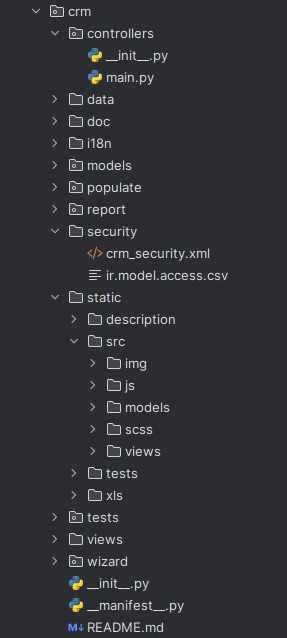The most important aspect of developing a module is its structure. When we create a
module, it has its own structure,
which we should always adhere to. A module is made up of various components such as
models, views, security and so on.
An Odoo module is primarily declared by its manifest.
Each module requires a python file and a manifest file, which are named __init__.py and
__manifest__.py, respectively. The module's basic structure is shown below.

A module is also a Python package that includes a __init__.py file with import
instructions for the module's numerous Python files. For example, if the module only has
one python_file.py file, the __init__.py file contains:
from . import python_file
__manifest__.py
In the manifest, we can describe the module name, author name, version, description,
company, category, and so on.
Name - The module's name.
Description - A brief summary of the module.
Version - We can specify the module version here.
Licence - Enter the distribution licence here.
Author - The module's author name.
Website - The URL of the module's author's website.
Category - Specify the name of the category.
Depends - We can specify a list of modules that must be installed prior to installing the
module here.
Data - These files are installed or updated as part of the module installation.
Demo - The data files that are installed or updated during active demonstration mode.
The module includes directories. Models, views, demos, static, security, data, wizards,
and so on are all part of it.
Model
The model file consists of the __init__.py file, which imports all Python files in the
model's directory.
Views
Views files are XML files that contain user interface actions and views such as forms,
lists, and so on. "demo.xml" is the file format for creating an XML file.
Data
The data file contains all data files as well as the module's initial data.
Demo
It is made up of data files containing demonstration data, which can be used for testing,
training, or module evaluation.
i18n
The translation files, which include.po and .pot files, are contained in the i18n file.
These files do not need to be mentioned in the manifest file.
Security
It is made up of XML files that create access groups and record security rules, as well
as data files that define access control lists, such as the ir.model.access.csv file.
Controllers
The Controllers folder contains code files that provide website controllers with that
functionality.
Static
The static directory contains all assets that are expanded. The files in this directory
are open to the public and can be accessed without a username and password. This
directory contains JavaScript, style sheets, images, and other items not listed in the
module manifest but referenced in the web template.
Wizard
The wizard contains all wizard-related files. In Odoo, wizards are used to store
intermediate data.
Reports
Odoo assists us in producing PDF documents such as invoices and sales orders. The report
directory contains all report-related files.